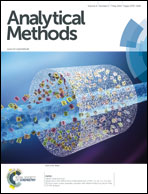Electrochemically controlled solid phase microextraction of ibuprofen based on nanostructure conducting molecular imprinted polypyrrole and selective analysis in biological and formulation samples using ion mobility spectrometry
Abstract
The present work describes a combination of conducting molecularly imprinted solid phase microextraction with electrochemistry for a sample clean-up and selective determination of ibuprofen (IBP) by ion mobility spectrometry (IMS). Overoxidized polypyrrole film template with IBP was utilized as a conducting molecular imprinted polymer (CMIP) for potential-induced highly selective solid-phase microextraction processes. Several parameters such as uptake and release potential, uptake and release time were investigated to achieve the optimum microextraction procedure. The calibration graph was linear in the ranges of 5–100 and 100–1000 μg L−1, the limit of detection was 2.5 μg L−1 and RSD% (n = 5) was lower than 6%. The proposed method was applied for a successful clean-up and quantification of trace amounts of IBP in biological and formulation samples.


 Please wait while we load your content...
Please wait while we load your content...